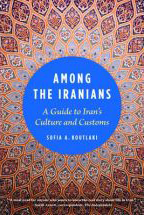 Review by Bruce Byers
Review by Bruce Byers
Sofia Koutlaki, Among the Iranians: A Guide to Iran’s Culture and Customs, Intercultural Press: Boston, 2010, ISBN- 13:978-1931930901, 240 pp., $24.95
Greek-born Sofia Koutlaki has written an important and helpful book, Among the Iranians – A Guide to Iran’s Culture and Customs, that offers readers detailed information about many of the cultural mores and traditions in today’s Iran. Ms. Koutlaki has long been married to an Iranian and has lived for many years in and outside of Iran. When she first arrived in Tehran she spoke no Persian, and this put her at an initial disadvantage which she soon overcame. She has conducted extensive research and interviews to create a very useful guide for foreign visitors to Iran.
Prior its publication Ms. Koutlaki had conducted research and written extensively about communication and social interaction among Iranians. Her Ph.D. thesis The Persian system of politeness and Persian folk concept of face, with some reference to EFL teaching to Iranian native speakers (University of Wales, 1997) forms a background for many of her comments about the importance of etiquette and the concept of “face” among different individuals and groups in Iranian society. Readers should keep this in mind when reading her guide because she delves into many facets of contemporary Iranian society and shows connections between them and the underlying cultural influence and meaning of Shi’a Islam in a broader social context.
Ms. Koutlaki offers us a different way of knowing about another people and their culture. If there is a common thread that runs throughout her guide it is that Iranian society with all of its diversities and paradoxes is resilient and has withstood many assaults over the millennia of its existence. Her guide is not a travelogue or a definitive sociological analysis of contemporary Iranian life. Instead it gives us clear explanations with examples of how people in Iran live, communicate, and cooperate among themselves in ways that might appear strange and foreign to most Americans. It is written as a help in understanding the many levels of social behavior among people one might meet in Iran. Through her experiences with Iranians, including her husband and his family, she shares her curiosity and appreciation for their society and customs.
In each chapter she illuminates different aspects of culture and custom and extends our view far beyond the media depictions of events in Iran. She leads us to a better understanding of the ways in which Iranians cope with their daily lives. Her guide offers practical advice and gives us examples from her own experiences. Her descriptions help us to push aside stereotypes and focus on deeper aspects of Iranian life. This is probably the most important contribution her guide makes.
Her discussion of differences between Iranian cultural trends and those of American, British and other Western societies is important for those of us who are in the business of diplomacy and negotiation. We learn about the ways in which people in Iran perceive their responsibilities and duties and how these are rooted in a very ancient culture that is not Western despite appearances and emulations. This is an important distinction because it offers us a basis for understanding why and how the different peoples of Iran with their customs, histories, and languages have formed a unified nation over many centuries that is independent, proud and even nationalistic in the face of external threats. Her guide also helps us understand why there are disparities and misunderstandings in Iranian society and among different social and economic classes.
She emphasizes in several parts of the guide that Iranians are non-confrontational and seek to maintain social and familial equilibrium. They prefer to negotiate important matters using polite formalities and indirect approaches. This could lead a foreigner to conclude that they are two-faced and cannot be trusted, but this would be a serious misjudgment of cultural rules and traditions. Those of us who come from societies in which business dealings and diplomatic negotiations are often confrontational will appreciate Koutlaki’s explanations about Iranian indirectness and inductive approaches to problems. These approaches are rooted in very old cultural values having to do with personal and group identities. Confrontation tends to increase a passive aggressive response and this is something most Iranians try to avoid.
Her discussion of personal identity and “face” is a key to understanding many of the chapters in the guide. Every society, culture and subculture contains a basis for personal identity. In group-oriented societies an individual’s identity is more deeply rooted in family roles with one’s responsibilities being defined by one’s place in the family. In these societies personal independence is secondary to the importance of family ties and duties and this distinction is paramount to understanding individual behavior in Iranian society. “Face” concerns the way people project themselves in their world. It involves deeply intimate feelings, vulnerabilities and pride. Each of us, no matter in what culture we live, seeks to get along with other members of our immediate group however defined and each of us takes cues for doing so from others who we respect or dislike. Preserving one’s face involves fulfilling personal responsibilities and duties towards family members, friends, business associates and others including foreign visitors. Such responsibilities can vary significantly from society to society and culture to culture and Koutlaki’s guide shows how they are manifested in contemporary Iranian society where they are rooted in Islam and the Koran as well as in much older traditions.
Her discussion of Shi’a Islam’s history and significance for Iranians, though necessarily brief, is very concise and integrated with other chapters dealing with manners, duties, “face,” and social customs. She covers several important religious concepts that need explication for Western readers. Among these are the duties every devout Muslim must fulfill. Of special interest is her description of “jihad,” in its Koranic meaning of personal struggle. She points out that the word has been very abused and misused by people with other objectives than those set forth in the Koran.
Koutlaki is more expansive in her chapter about the importance of food in Iranian culture and even gives recipes for several basic and widely popular dishes. She emphasizes that most Iranians still prefer to buy fresh vegetables, fruits, meat, and other staples on a daily basis. Each household, no matter how modest, seeks to prepare food that is nutritious and meets Islamic dietary rules. Food plays a major role in Iranian hospitality and the author explains how it is used in entertaining guests. There is a discussion of culinary hygiene and the importance of freshly slaughtered animals used in preparing dishes. She emphasizes how the preparation and enjoyment of food ties families together. Traditionally, some portion of food is set aside for indigents who might knock on one’s door asking for something to eat. This set-aside conforms to Islamic teachings about helping the less fortunate.
In the final chapter Koutlaki deals with some of the paradoxes and contradictions in Iranian life that might confuse visitors from other cultures. She refers to earlier chapters in illuminating them. One of the most interesting is her discussion of personal behavior among people at home or in the office and their behavior while driving in traffic. The anonymity of motorists moving in traffic often leads to incidents that contradict the rules of etiquette about giving way to the other person. The author explains that this paradox is most likely rooted in the cultural concept of “in-group/out-group” behavior wherein people who recognize their roles as part of a larger group of friends and acquaintances show deference to elders and those in positions of higher authority while displaying a more reserved attitude towards strangers who are not part of their group. In traffic everyone is independent and many drivers display their independence by cutting off other motorists or zipping through intersections as lights turn red. This kind of behavior is certainly known in America and other Western countries.
She also discusses popular beliefs rooted in ancient cultural and religious tenets including Sufi mysticism and the poetic traditions of Hafez and others. A Western visitor might see these as superstitions and puzzle at how seemingly educated, intelligent people could hold beliefs such as in the influence of the “evil eye” or in specific poetic auguries. Iranians are not alone in observing beliefs that might strike an outsider as illogical or irrational. Every society harbors its own collection of irrational beliefs and superstitions. It is important to the understanding of different cultural traditions and customs to see how they influence human behavior in positive and negative ways and Koutlaki’s guide about Iran is certainly a help in this direction.
In an epilogue the author describes Iranian society as being in a transformative process and points to the increasing impact of modern technology on customs and traditions that has occurred within a single generation. As the number of “nuclear families,” and work and careers has increased, old customs have started to break down. At the same time, new means of immediate communication—the cellphone and the Internet—have spread rapidly, enabling family members and friends to stay in touch despite distances and increasing stresses arising from modern urban life.

Bruce K. Byers lived in Iran and worked as a cultural affairs officer at the U.S. Embassy in Tehran from 1972-74. He traveled widely in Iran and met with many people at universities, colleges, news media, and cultural institutions.
